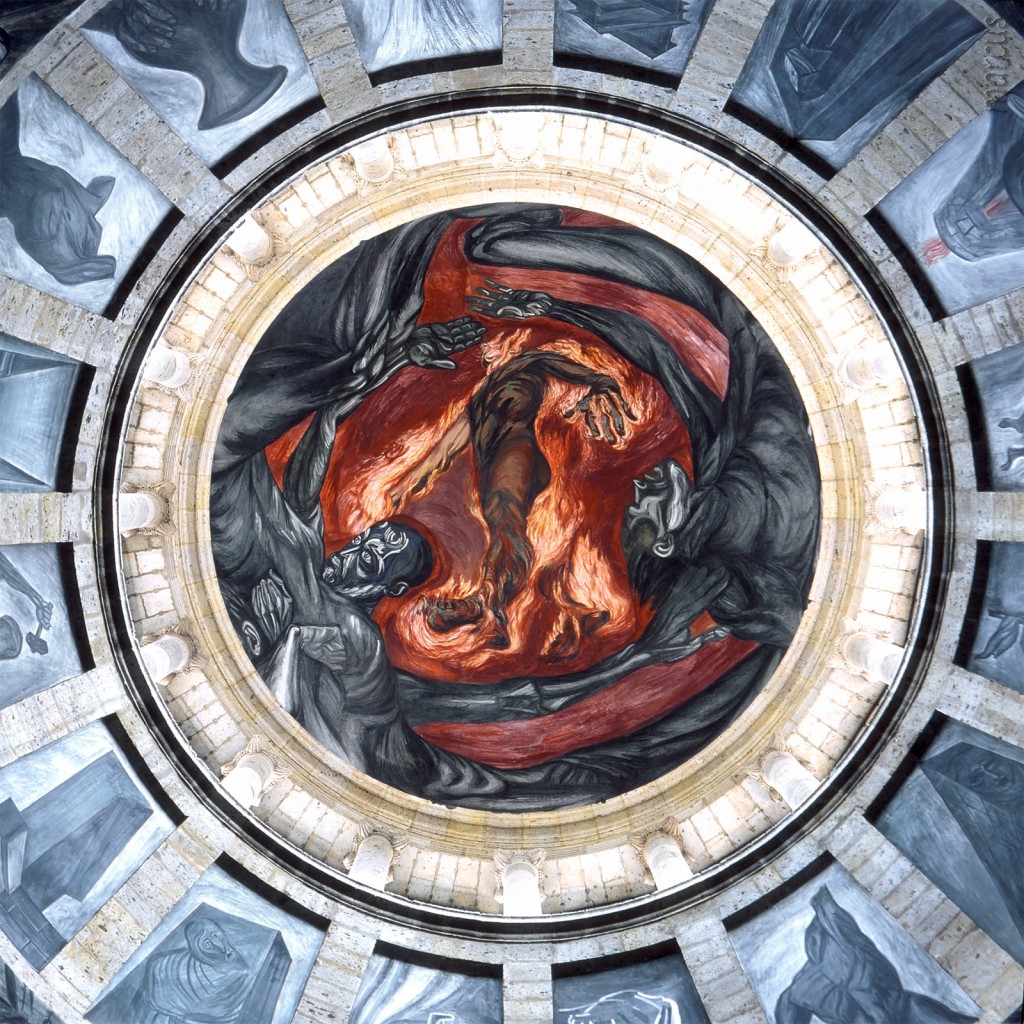Man of Fire

……
-Jose Clemente Orozco; Man of Fire; 1938-9; Hospicio Cabanas, Guadalajara-
Jose Clemente Orozco (1883-1949) was a socially-conscience Mexican muralist whose works expressed sympathy towards the causes of the lower working classes. He was born on November 23, 1883 in Jalisco, Mexico, and at an early age he lost his left hand while playing with gunpowder. This didn’t stop him from wanting to becoming an artist though, and he later attended the San Carlos Academy for Fine Arts in Mexico City. The bloody Mexican Revolution deeply influenced Orozco’s view of the world, as is deeply evident in the content of his works — on one hand, he remained throughout his life an ardent supporter of the causes of workers and peasants, but he also harbored a deep pessimism about the moral state of humanity.
This particular mural is regarded as both Orozco’s masterpiece and one of the finest murals ever created in the twentieth century, and its not hard to see why. Painted in the Hospicio Cabanas in Guadalajara, this mural depicts a man, wreathed in flames, ascending into the roof of the structure. Surrounding him are a mass of dark grey figures representing the natural elements (Earth, Air, Water and Fire), and lower still are 16 vaguely unsettling images arrayed around the cupola.
I think this is an astounding mural. It’s bold, powerful and dramatic. The artist’s minimalist use of colors (just shades of blue, grey and red) appeals to me as well. Clearly, this artist was at the top of his game. It’s no surprise that Man of Fire and it’s surrounding fresco is considered by some to be the “Sistine Chapel of the Americas”
However, I also found Man on Fire quite difficult to grasp. While I do find it impressive, dramatic and powerful, I don’t quite understand the meaning behind it. I understand that it’s a metaphor for social struggle, but the meaning behind the symbolism is beyond me. I searched for an analysis, but I couldn’t find any solid, specific explanation behind the imagery.
Still, I’m impressed by this work and am able to appreciate it. All of Orozco’s work is powerful, but I feel this one has a special kind of authority and significance.
.
.
.
.
<Sources>
http://www.wfu.edu/history/StudentWork/fysprojects/kmason/Omnfueg.htm
http://www.wfu.edu/history/StudentWork/fysprojects/kmason/Orozco.htm
http://en.wikipedia.org/wiki/Jos%C3%A9_Clemente_Orozco
http://gomexico.about.com/od/guadalajara/ss/hospicio_cabanas_3.htm
https://www.msu.edu/user/hockettj/Orzcpap.htm
http://www.pbs.org/wnet/americanmasters/episodes/jose-clemente-orozco/orozco-man-of-fire/82/

I really like the piece of art you chose from Orozco. It is really appealing visually. I love the intense red colors, and the different
blue tones as well as grey tones. This mural expresses the influence of the Mexican Revolution for sure because this mural shows a man in flames which I believe represents the suffering of men during this period of time. You did a good job. You met all the criteria for this assignment.
Wow. This is amazing!!! I didn’t even see this one. Great job on filling us in on the background of the artist and masterpiece and also adding your thoughts. I really enjoyed it. It was a good read. : )
As you said, the precise meaning is difficult to decipher. The smaller works surrounding the centerpiece each seem to have specialized significance pertaining to the main theme. Whatever the artist’s specific intention was behind this work it still manages to evoke a rather strong feeling. Nice choice, and good job.
Great job! All of the information is there and you cited your sources.
Thank you for sharing about Orozco’s background and how he lost his hand. People like him should be an inspiration to never give up on what you want to do in life! You’re right, it would be nice to know the symbolism behind the work. But, it’s also fun to make our own meaning of things sometimes!
I’m currently reading a book which mentions this “Man of Fire” which led me to find your photo here.
From the book…
“There is a dome at the center of the orphanage in Guadalajara, and Orozco has painted on it his ‘man of fire.’ This is one of the first portrayals of planetary man: the man who has lived through the World Wars, and who rises from that holocaust like a flame. His body is the red of revolution; one sees it from below ascending upward through the dome. It is a resurrection body; he is victor over death who now moves into an unknown future.”
~Clinton C. Gardner, “Letters to the Third Millennium”, Argo Books, 1980.